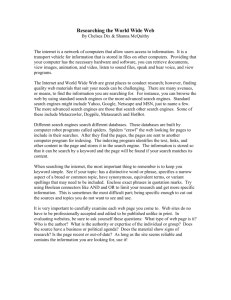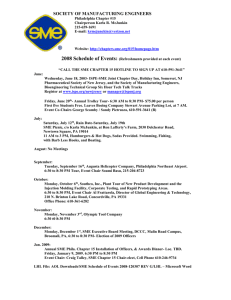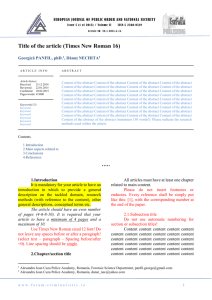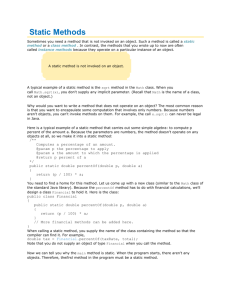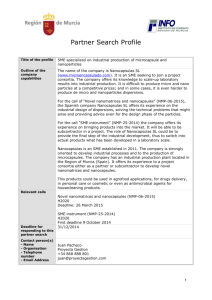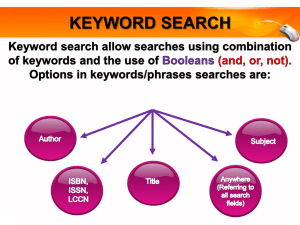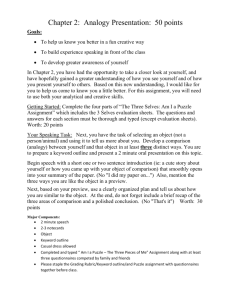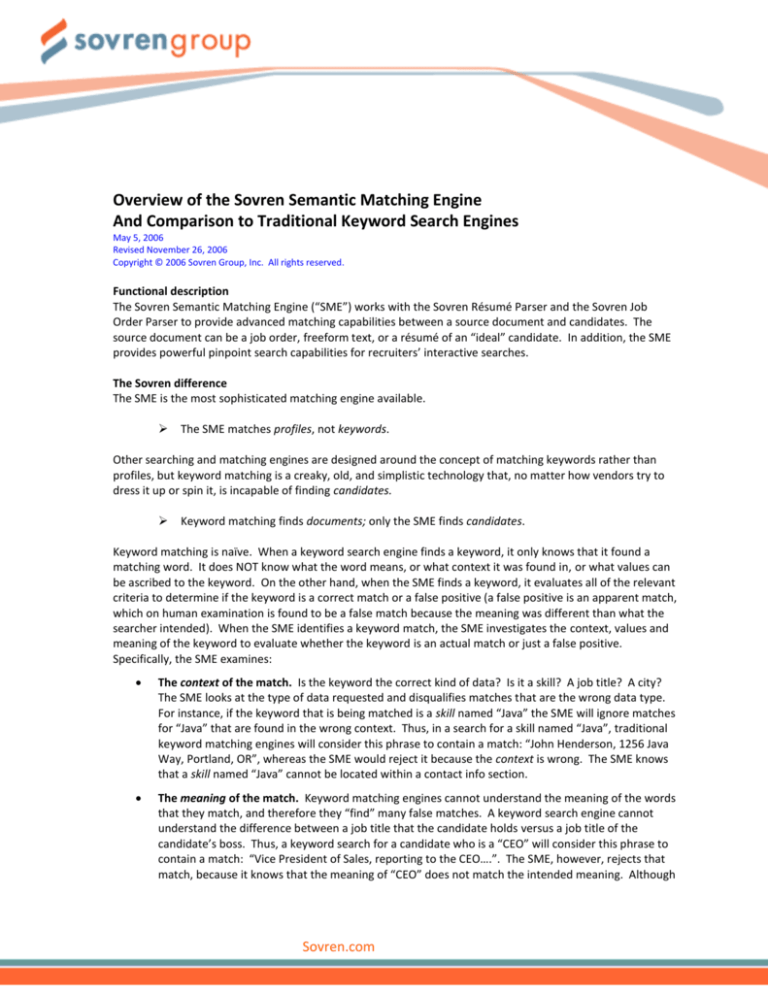
Overview of the Sovren Semantic Matching Engine
And Comparison to Traditional Keyword Search Engines
May 5, 2006
Revised November 26, 2006
Copyright © 2006 Sovren Group, Inc. All rights reserved.
Functional description
The Sovren Semantic Matching Engine (“SME”) works with the Sovren Résumé Parser and the Sovren Job
Order Parser to provide advanced matching capabilities between a source document and candidates. The
source document can be a job order, freeform text, or a résumé of an “ideal” candidate. In addition, the SME
provides powerful pinpoint search capabilities for recruiters’ interactive searches.
The Sovren difference
The SME is the most sophisticated matching engine available.
The SME matches profiles, not keywords.
Other searching and matching engines are designed around the concept of matching keywords rather than
profiles, but keyword matching is a creaky, old, and simplistic technology that, no matter how vendors try to
dress it up or spin it, is incapable of finding candidates.
Keyword matching finds documents; only the SME finds candidates.
Keyword matching is naïve. When a keyword search engine finds a keyword, it only knows that it found a
matching word. It does NOT know what the word means, or what context it was found in, or what values can
be ascribed to the keyword. On the other hand, when the SME finds a keyword, it evaluates all of the relevant
criteria to determine if the keyword is a correct match or a false positive (a false positive is an apparent match,
which on human examination is found to be a false match because the meaning was different than what the
searcher intended). When the SME identifies a keyword match, the SME investigates the context, values and
meaning of the keyword to evaluate whether the keyword is an actual match or just a false positive.
Specifically, the SME examines:
The context of the match. Is the keyword the correct kind of data? Is it a skill? A job title? A city?
The SME looks at the type of data requested and disqualifies matches that are the wrong data type.
For instance, if the keyword that is being matched is a skill named “Java” the SME will ignore matches
for “Java” that are found in the wrong context. Thus, in a search for a skill named “Java”, traditional
keyword matching engines will consider this phrase to contain a match: “John Henderson, 1256 Java
Way, Portland, OR”, whereas the SME would reject it because the context is wrong. The SME knows
that a skill named “Java” cannot be located within a contact info section.
The meaning of the match. Keyword matching engines cannot understand the meaning of the words
that they match, and therefore they “find” many false matches. A keyword search engine cannot
understand the difference between a job title that the candidate holds versus a job title of the
candidate’s boss. Thus, a keyword search for a candidate who is a “CEO” will consider this phrase to
contain a match: “Vice President of Sales, reporting to the CEO….”. The SME, however, rejects that
match, because it knows that the meaning of “CEO” does not match the intended meaning. Although
Sovren.com
in both cases the “CEO” is indeed a position title, only the SME is able to reject the false match
because only the SME knows that the candidate himself was not a “CEO”.
The value of the match. Keyword search engines cannot determine the values associated with a
match. Thus, a keyword search for a candidate who is a
“Sales Manager”
cannot be limited to candidates who have the desired values attributable to “Sales Manager”. A
keyword search engine will therefore identify as a match any candidate on whose Résumé the term
“Sales Manager” appears. The SME is not so naïve. A candidate who was a “Sales Manager” from
1994-1999, but who has since been elevated to CEO, will be (falsely) considered to be a match by a
keyword search engine, but not by the SME. But that candidate is NOT a match, because candidates
do not step down from CEO positions to become Sales Managers. The SME understands that this
candidate is not a match because the values associated with his Sales Manager position disqualify
him from being a true match. The SME knows that a candidate who long ago was in a certain
position, but who has since moved on, is not a match, but rather, is a waste of a recruiter’s time.
The experience profile of the match. Consider a job opening for a
“Sales Manager with 10 years of total experience and 5 years of management experience.”
Any candidate with “Sales Manager” on her Résumé is going to be selected as a match by a keyword
search engine. The SME, by contrast, understands the entire profile of the candidate; thus, the SME
will correctly reject a “Sales Manager” who has only four years of total experience and 6 months of
management experience, because her profile does not match the job order’s profile.
The skills profile of the match. Consider a job opening for a
“Java programmer with 5 years of experience.”
Any candidate with “Java” on her Résumé is going to be selected as a match by a keyword search
engine. The SME, however, understands the entire profile of the candidate, including the skills
profile. Since more than half of all IT candidates have some Java experience, or exposure to Java
products, it is important to exclude those candidates who are actually not Java programmers. Many
candidates who are help desk workers or database administrators will also have some exposure to
“Java” products on their Résumés. But these candidates are not Java programmers; they are
something else, plus they have a little exposure to Java. The SME understands this difference, and
can therefore reject all candidates who have Java exposure but whose core identity is not “Java
programmer”.
The ranged data values of the match. Consider a job opening for a
“Current Java programmer with 5 years of Java, and a GPA of 3.5 or higher”.
This type of search is impossible for a keyword search engine to perform. A keyword search engine
can only match discrete pieces of data, not ranged classifications. It is impossible to search for a
candidate with a “GPA of 3.5 or higher” using a keyword search engine; it is impossible for it to find
candidates with “5 years of Java”; it is impossible for it to just find candidates who are current or
recent Java users rather than former Java users; and it is impossible for the keyword search engine to
Sovren.com
even exclude candidates with “Java” on their Résumé in the wrong context (i.e., as something other
than a skill).
Thus, the only search that a keyword search engine can perform in order to fill this job order is just to
find Résumés that have the word “Java” on them. The SME, on the other hand, can search for
candidates whose profiles show that they have about 5 years of a skill named Java, who are current
or recent users of a skill named Java, and who have a GPA of 3.5 or higher on a 4.0 scale.
The simplistic keyword search engine will “match” all candidates with the word “Java” on their
Résumés. This is really not a search; it’s actually what we refer to as a dredge. Instead of finding
the oyster with the pearl, the keyword search engine can only dredge up the whole seafloor and
force the recruiters to shuck open each oyster to look for the few that contain a pearl.
The SME, by contrast is extremely smart. The SME will bring back just the oysters who have a pearl
inside. Instead of shucking 10,000 oysters to find just one pearl, SME users can open just the few
dozen oysters that were retrieved by the SME, all of which contain a pearl.
Let’s say the seafloor contains 30,000 oysters, of which 13 have a pearl inside. The SME and the
keyword search engine will theoretically find the same 13 pearls. The difference is that the SME will
immediately find and retrieve just the 13 oysters with a pearl inside, whereas the keyword dredging
operation will pull back all 30,000 oysters and all 30,000 oysters will have to be shucked open to find
just the 13 pearls. The SME users will have found their 13 pearls in seconds; the keyword search
engine users will probably give up after hours of shucking when they finally find their first pearl.
Real world search example
Let’s try to fill a job order by searching a repository of 47,000 Résumés using a keyword search engine and
then using the SME. Let’s try to fill the Sales Manager position for our new Latin American sales division.
Here’s our job order, expressed in informal terms:
“Bob, find me a smart, experienced, affordable Java programmer.”
Using keyword searching
A keyword search for “ Java AND programmer ” returns thousands of matches.
A search for the exact phrase “Java programmer” returns 270 matches, a more reasonable number,
but this search has the unfortunate side effect of eliminating experienced Java programmers on
whose Résumé the exact term “Java programmer” does not appear. Thus, a candidate who is a “Java
internet applications programmer” will be excluded.
A search for the word ‘Java’ within five words of the word ‘programmer’ returns 449 matches
because it now includes candidates who have experience terms such as “Java internet applications
programmer”.
So, the keyword dredge has hauled up 449 Résumés for us to read. We will have to read each
Résumé to see if the candidate actually meets the qualifications.
Sovren.com
Using the SME
A semantically correct search using the SME is precisely targeted. The SME search returns exactly 12
candidates who are actually current Java programmers, who have about 5 years of Java, and who are
smart (high GPA). These candidates are also likely to be affordable because they are likely to be fairly
fresh in the workforce (candidates tend to omit their GPA after they have been in the workforce for a
while).
Comparison of results
The SME search reveals that there are 12 candidates whose profiles exactly match the job order
profile. The SME identified 100% of those 12 candidates, with no false positives, in just a few
seconds.
The keyword search dredged up 449 résumés. Recruiters will have to manually open and read each
Résumé to find the 12 candidates who actually fit the job order profile. 97% of the matches returned
by the keyword search engines are actually false matches. If it takes a recruiter only 45 seconds to
open each Résumé and read and analyze it, it will take over 5 ½ hours to find the 12 true matches.
The SME returned the exact matches 10,000 times faster.
The bottom line on keyword searches
Keyword searches fail on the common searches that comprise 80% of your placements.
The bulk of all job orders are looking for things that are common, such ‘Java’ or ‘typing’ or ‘Sales Manager’ or
‘Excel’. [This rule is always true, because it is a tautology.] There are far more job orders for ‘Administrative
Assistant’ than for ‘Space Shuttle Engineer with extensive experience in BV67H22 orthography techniques’.
Unfortunately, with keyword searching, the more common the keyword, the less effective the search.
For that one job that needs ‘BV67H22 orthography’, keyword searching will find the two or three candidates
that have that term on their Résumé, and because the term is so exceedingly rare, there will be few if any
false positives. But ‘BV67H22 orthography’ is not a bread-and-butter placement, it’s a “one off” rarity. For
the common placements, those ‘Administrative Assistant with 2-5 years of experience and 60 wpm typing’
jobs, keyword searches fail miserably, dredging up huge amounts of false matches and forcing the human
recruiter to be the real search engine.
Ignore the man behind the curtain
Because of the glaring shortcomings of keyword search engines, vendors try very hard to make their engines
appear much smarter by claiming that their engines employ “advanced” techniques such as “concept
searches”, “natural language searches”, “linguistic analysis”, “density ranking”, “distance algorithms”, etc.
These are all just attempts by The Great Oz to get you to ignore the man behind the curtain.
All “enhancements” and “advanced features” of keyword search engines are just attempts to
compensate for the naivety of the search engine by trying to rank the results in a way that might
Sovren.com
make the top-ranked results actually contain some truly useful matches. These features do not
improve the accuracy of the searches at all; they only affect the way the results are ordered.
If the keyword search engine were smart enough to match profiles rather than keywords, thereby
eliminating the 90+% of all matches that are actually false positives, there would be no need for these
“advanced” features. The “advanced” features are not searching and matching features; they are just
attempts to reorder the results so that fewer false positives appear early in the result set.
For example, “linguistic analysis”, when used by a search engine that can not and does not understand the
target documents, is just a euphemism for “We haven’t got a clue what the Résumés mean, but we’re going to
examine the grammar a bit and see if we can figure something out.” It’s useless.
“Density ranking” is another often-used “advanced” feature of keyword search engines. Density ranking does
NOTHING to find better matches; density ranking just means that once the matches are dredged up, the
documents will be ranked so that the first documents shown will be those with the most keyword “hits” in the
least amount of total text. Which, of course, is just another simplistic attempt to try to compensate for the
fact that the 90+% of the “matches” that the search dredged up were really just false positives.
Although density ranking seems somewhat useful – or, at least, harmless – it’s actually counterproductive.
Why? Because candidates have learned to game the system. Candidates are well aware that by grouping
their skills keywords into big “Skills” paragraphs at the top and bottom of their Résumés, they can ensure that
they will be ranked higher by the “density ranking” algorithm. So, the density ranking algorithms do not
highlight the best candidates, but rather, the most annoying candidates, the ones who have learned to gussy
up a feeble work history with dozens of buzzwords and keywords stuffed into extraneous paragraphs. That’s
who density ranking algorithms are best at identifying: the candidates who play games with their Résumés.
What about “concept searching”? One vendor likes to wow prospects with this “concept searching” scenario:
If you are trying to fill a position for a Photoshop expert, you can search for “graphic artist” instead
and it will find people with Photoshop experience.
Before we explain how concept searching works and why it’s not a sophisticated feature, let’s just examine
the value proposition given above. Let’s ask the obvious question: “Why would I want to hire a graphic artist
with no Photoshop experience for my Photoshop job opening?” Of course, the question is also the answer: “I
wouldn’t”. Anybody who has ever dealt with graphic design knows that Photoshop is the lingua franca of all
graphic designers. If you do not know Photoshop, you are almost certainly NOT a professional graphic
designer. There is ZERO, in fact, NEGATIVE, value to this “conceptual search”. If you are looking for a
Photoshop expert, finding a guy who just knows crayons is not helpful.
In any case, concept searching is little more than using a thesaurus to expand the search silently behind the
scenes. So, you have a thesaurus or synonym table or skills cluster that says that all of these terms are
related:
Photoshop
Corel Draw
Adobe Illustrator
Graphic designer
Sovren.com
And then when someone wants to do a “concept search” for one of these terms, behind the scenes the search
term is built as “Photoshop OR Corel Draw OR Adobe Illustrator OR Graphic designer”. It’s just a simplistic
synonym search that will dredge up huge amounts of “matches” for the human search engines to examine.
Although calling it a “concept search” makes it seem sexy and valuable, it’s really not. Sexy and valuable is
using the SME to find exactly those candidates who have 10 years of experience, are graphic designers, have
at least 5 years of Photoshop, and are currently using it.
So, does the SME support these “advanced” features? Yes, because in addition to the intelligent semantic
matching of profiles, the SME can execute all of the traditional naïve keyword searches, including all of the
advanced features. So, the SME includes all the features and power of traditional keyword search engines,
and then adds its semantic profile matching capabilities.
Remember that keyword search engines can only find documents, not candidates. The raw material that
keyword search engines index and search is the plain text of the Résumés. The raw material that the SME
indexes and searches is the HR-XML parsed output from the Sovren Résumé Parser.
So, there are two parts of the equation that need to work together: the parsed HR-XML résumés, and the
SME’s parsing and query engines. We will first consider the parsed HR-XML.
How the Parser Includes Search Hints in the Generated HR-XML
The SME requires that the parsed HR-XML résumés contain SME-specific data in addition to the normal parsed
output. This requirement exists solely for performance reasons. Although a normal parsed HR-XML résumé
contains all of the information needed to perform powerful queries, it does not provide this information in a
way that is directly and efficiently usable by search engines. Thus, searching within an HR-XML parsed résumé
for such things as “current job title is Vice President” is possible, but not efficiently, because search engines
will not be able to directly associate the two pieces of data by referring to an index; rather, they will have to
scan the full text of the HR-XML to see if the data exists in the proper order and placement and relation. This
full text scan is extremely inefficient, and therefore we need a better way to associate logical pieces of data
that would normally be used in search queries.
In order to provide this more efficient query capability, the Sovren Résumé Parser can be configured to
provide embedded search hints that can be used by the SME. In addition, the Parser will normalize important
parts of the data to further increase the efficiency of the searches. It is necessary that this information be
embedded in the HR-XML files, or the SME will not be able to perform its queries.
Using résumés/CVs as source documents
In some cases, a résumé of an existing employee or of an “ideal candidate” may be a good source document
to use for finding similar candidates. The SME can use résumés/CVs in either plain text form (i.e., after
conversion to plain text using the Sovren Document Converter), or in previously-parsed HR-XML form.
Sovren.com
Using job orders as source documents
Job orders, in plain text form, can be used as source documents for the SME.
Summary
The Sovren Semantic Matching Engine marries the power of the Sovren Résumé Parser and the Sovren Job
Order Parser to provide accurate, ranked matches using sophisticated context-aware semantic matching of
profiles, not keywords. This technology is massively scalable.
Keyword matching finds documents; only the SME finds candidates. The precision, power and speed of the
SME can accelerate the process of finding candidates by several orders of magnitude. A 100-fold decrease in
time-to-find is possible.
Sovren.com


